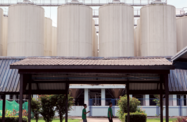Toyota is developing an assembly plant in Myanmar, signalling strong growth prospects in the local market as the country looks to expand its manufacturing output.

In late May the Japanese carmaker announced it will establish its first vehicle assembly plant in the country, in the Thilawa Special Economic Zone (SEZ) just outside of Yangon.
Once it is fully completed in 2021, the $52.6m plant will have the capacity to assemble around 2500 Toyota Hilux pickup trucks per year from semi-knocked-down (SKD) kits.
At present, Toyota exports some 2000 passenger and commercial vehicles to Myanmar for sale through authorised dealerships. The new development will see it follow in the footsteps of Suzuki and Nissan from Japan, Hyundai and Kia from South Korea, and Ford from the US, each of which has a production or assembly presence in the country.
There has been a recent rise in car sales stemming from the government’s decision in 2016 to impose import restrictions on second-hand vehicles, and then in 2017 to offer tax incentives for companies that assemble vehicles locally.
Compared to cars that are imported as a finished product, locally produced SKD vehicles tend to be less expensive for the end-consumer. New car sales totalled 17,000 units last year, double the figure in 2017.
Furthermore, with a population of around 54m – 55% of whom are under the age of 30 – and a rapidly growing economy, industry experts are confident that demand for new vehicles will continue to increase.
“There is also increasingly strong business-to-business growth in the market,” Yoshihisa Tonozuka, chief representative of Toyota in Myanmar, told OBG. “With strong agricultural, extractive and industrial sectors, we expect 4x4 vehicles to drive our growth and contribute to the development of Myanmar industries.”
See also: The Report – Myanmar 2019
Reforms to support manufacturing growth
This spike in automotive activity aligns with government efforts to develop the broader manufacturing sector.
Under the industrial development strategy, implemented in 2016, officials are targeting annual sector growth of 5-6% through to 2030, in order to drive local production and reduce reliance on imports.
To help meet these goals, a series of reforms has sought to improve the domestic business climate and incentivise foreign investment.
These include the Myanmar Companies Law of 2017, which allows foreigners to acquire a 35% stake in local companies, along with tax incentives designed to encourage domestic production. For several years, developing SEZs has also been a key element of government strategy.
Such measures appear to be having a positive effect. According to the Asian Development Bank, the industry and services sector expanded by 8% last year, outpacing an overall economic growth rate of 6.8%.
While the industrial sector already accounts for 16% of the workforce, further expansion of activity could give rise to significant job opportunities. Toyota anticipates its assembly plant will create around 130 new jobs, which will be added to the total of 5000 positions generated inside the Thilawa SEZ as of February 2018.
Increased manufacturing boosts exports
Such reforms have also helped expand exports, with the garments and footwear segment one of the key areas to have benefitted.
According to the Myanmar Garment Manufacturers Association, the country exported $2.7bn in garments and $300m in footwear during FY 2016/17, representing an increase of 28% from the previous year. Figures for 2018 are expected to have reached $3bn and $400m, respectively.
An increase in outward shipments is key to meeting the government’s broader fiscal goals and reducing the trade deficit. During the first nine months of FY 2018/19, which began in October, the trade deficit was $1bn, an improvement on the $3bn shortfall recorded in the corresponding period of FY 2017/18.
International support key to unlocking potential
Various international partners have played a significant role in helping Myanamar develop its exports.
The National Export Strategy 2015-19 was put in place with funding from the UK’s Department for International Development and technical assistance from the Geneva-based International Trade Centre (ITC).
And in August the government signed a financing agreement with officials from the EU and the ITC, which will see the EU provide assistance of up to €8m.
Infrastructure and credit challenges
While reforms and new investment are helping to drive manufacturing and industrial growth, the sector still faces a series of challenges.
One of these is related to insufficient industrial infrastructure and the cost of establishing high-tech production capacity. For example, South Korean electronics company Samsung announced in July of last year that it was cancelling plans to construct a manufacturing plant near Yangon due to inadequate infrastructure.
Limited access to credit is another longstanding challenge hindering domestic companies from expanding industrial activity. In the most recent OBG Business Barometer: Myanmar CEO Survey, released in July, some 82% of those surveyed said access to credit was either difficult or very difficult.


